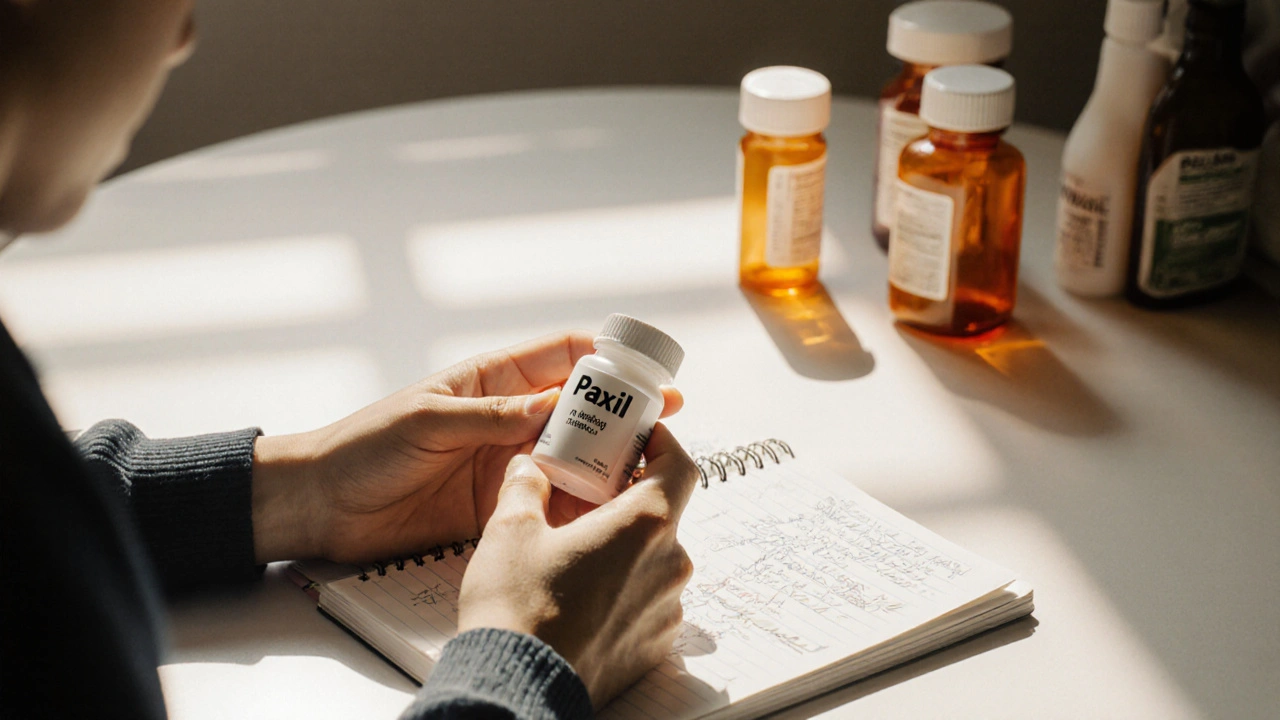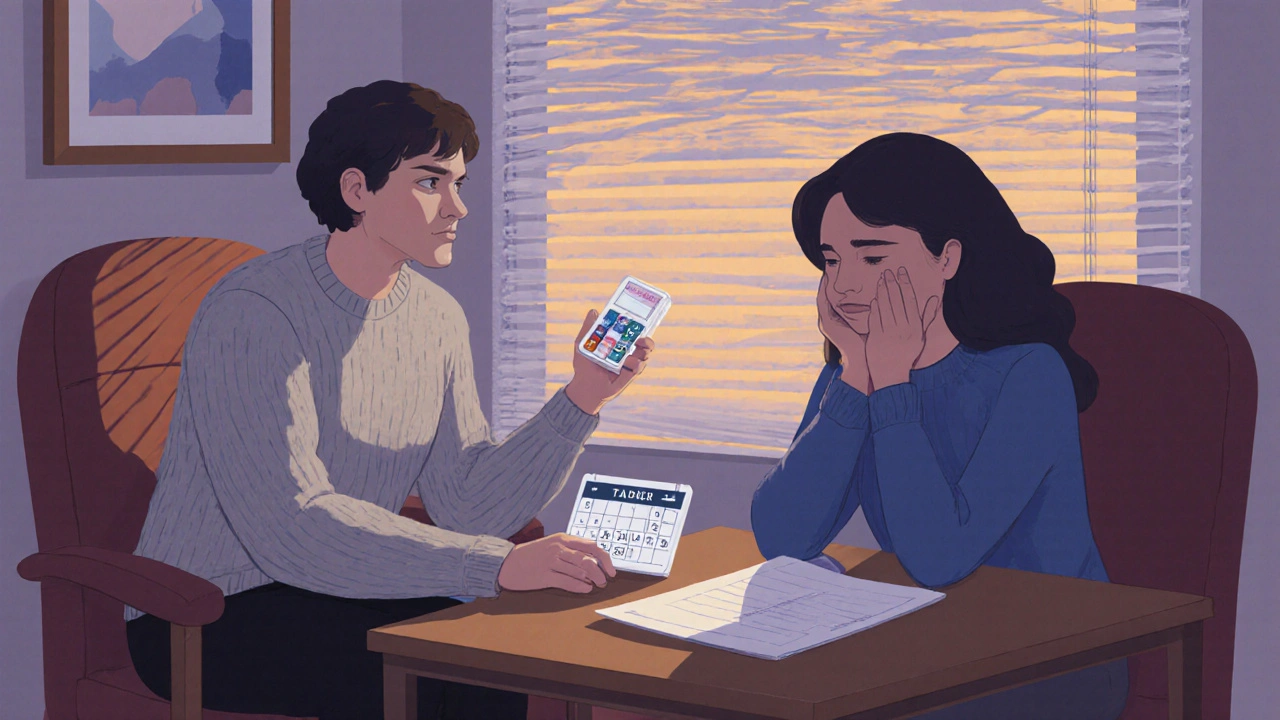Paxil (Paroxetine) vs. Alternatives: Comprehensive Comparison Guide

Antidepressant Comparison Tool
Select the medications you want to compare to see how they stack up on key attributes like side effects, withdrawal risk, and dosing convenience.
Paxil (Paroxetine)
SSRI antidepressant
Sertraline (Zoloft)
SSRI antidepressant
Escitalopram (Lexapro)
SSRI antidepressant
Fluoxetine (Prozac)
SSRI antidepressant
Venlafaxine (Effexor)
SNRI antidepressant
Duloxetine (Cymbalta)
SNRI antidepressant
Bupropion (Wellbutrin)
NDRI antidepressant
Comparison Results
Select at least two medications to view comparison results
Quick Summary
- Paxil (Paroxetine) is a potent SSRI often used for depression and anxiety but carries a higher risk of withdrawal and sexual side effects.
- Sertraline, Escitalopram, and Fluoxetine generally offer smoother tapering and fewer sexual problems.
- Venlafaxine and Duloxetine (SNRI) may help when anxiety is accompanied by chronic pain.
- Bupropion works well for patients who need less sexual dysfunction and want a modest boost in energy.
- Choosing the right drug hinges on effectiveness, side‑effect profile, drug interactions, and personal health factors.
When you or someone you care about is weighing Paxil against other options, the decision isn’t just about brand names. It’s about how each medication fits into a unique health picture. Below you’ll find a side‑by‑side look at the most common alternatives, the science behind them, and practical tips for switching safely.
Paxil (Paroxetine) is a selective serotonin reuptake inhibitor (SSRI) that boosts serotonin levels in the brain, helping to lift mood and calm anxiety. Approved by the FDA in 1992, it quickly became a go‑to for major depressive disorder, generalized anxiety disorder, and panic disorder. Its strength comes with trade‑offs: a short half‑life, notable weight gain potential, and a higher incidence of sexual dysfunction.
What to Look for When Comparing Antidepressants
Everyone’s experience is different, but most clinicians evaluate a few core factors:
- Clinical efficacy: How well does the drug relieve depressive or anxiety symptoms?
- Side‑effect profile: Does it cause weight changes, sleep issues, or sexual problems?
- Withdrawal risk: How hard is it to stop the medication?
- Drug interactions: Does it interfere with other meds you’re taking, especially those metabolized by CYP450 enzymes?
- Dosing convenience: Once‑daily vs. multiple doses, need for titration.
- Special considerations: Pregnancy safety, age‑related risks, comorbid conditions like chronic pain.
Side‑by‑Side Comparison Table
| Medication | Class | Typical Starting Dose | Half‑Life | Common Side Effects | Withdrawal Severity |
|---|---|---|---|---|---|
| Paxil (Paroxetine) | SSRI | 10mg once daily | ≈21hours | Sexual dysfunction, weight gain, nausea | High |
| Sertraline (Zoloft) | SSRI | 25mg once daily | ≈26hours | Diarrhea, insomnia, mild sexual effects | Medium |
| Escitalopram (Lexapro) | SSRI | 10mg once daily | ≈27hours | Dry mouth, fatigue, low sexual impact | Medium |
| Fluoxetine (Prozac) | SSRI | 20mg once daily | 4‑6days (active metabolite) | Insomnia, agitation, minimal weight gain | Low |
| Venlafaxine (Effexor) | SNRI | 37.5mg once daily | ≈5hours | Elevated blood pressure, nausea, sweating | High |
| Duloxetine (Cymbalta) | SNRI | 30mg once daily | ≈12hours | Dry mouth, constipation, mild liver enzyme rise | Medium |
| Bupropion (Wellbutrin) | NDRI | 150mg once daily | ≈21hours | Insomnia, dry mouth, rare sexual side effects | Low |
Deep Dive into Each Alternative
Sertraline (Zoloft) is often praised for its balanced side‑effect profile. It’s metabolized mainly by CYP2C19 and CYP2D6, making it less likely to clash with many heart medications. For patients who struggled with Paxil’s sexual dysfunction, sertraline usually offers milder effects, though insomnia can be an issue.
Escitalopram (Lexapro) is the S‑enantiomer of citalopram, giving it higher potency at lower doses. Clinical trials show comparable efficacy to Paxil for generalized anxiety, but with fewer reports of weight gain. Its primary drawback is a slightly higher cost in some markets.
Fluoxetine (Prozac) has the longest half‑life of the SSRI group, which translates to smoother discontinuation. It can be a good switch for patients who experienced severe withdrawal from Paxil. However, its activating nature may worsen anxiety in a small subset, so clinicians start at a low dose.
Venlafaxine (Effexor) works on both serotonin and norepinephrine, helping when anxiety coexists with chronic pain or fatigue. Its dose‑dependent blood‑pressure rise mandates regular monitoring, especially above 150mg/day. Withdrawal can be intense, so tapering must be gradual.
Duloxetine (Cymbalta) shares the SNRI mechanism but also has FDA approval for diabetic neuropathy and musculoskeletal pain. This dual benefit makes it attractive for patients with comorbid depression‑pain syndromes. Liver function tests are recommended before and during treatment.
Bupropion (Wellbutrin) boosts dopamine and norepinephrine without affecting serotonin, explaining its low sexual side‑effect rate. It’s also used for smoking cessation. The main caution is the seizure risk at doses >450mg/day, so it’s avoided in patients with a history of seizures.

When Paxil Might Still Be the Right Choice
Despite its drawbacks, Paxil shines in a few niches. Its strong serotonergic effect can be beneficial for patients with severe obsessive‑compulsive disorder (OCD) where other SSRIs fall short. The medication also has a well‑established pediatric data set for anxiety, making it a trusted option when a child’s weight gain risk is carefully managed.
Switching Safely: Practical Tips
- Taper slowly: Reduce Paxil by 10mg every 1‑2 weeks to minimize discontinuation syndrome.
- Cross‑taper when possible: Introduce the new antidepressant at a low dose while still on the reduced Paxil dose, then phase out Paxil completely.
- Monitor side effects: Keep a daily log of mood, sleep, and any sexual changes for the first four weeks after the switch.
- Check drug interactions: Review current meds for CYP2D6 inhibitors (e.g., fluoxetine) that could raise levels of the new drug.
- Seek professional guidance: A psychiatrist or primary‑care provider can adjust doses based on blood‑pressure readings for SNRIs or liver enzymes for duloxetine.
Frequently Asked Questions
Can I take Paxil with alcohol?
Alcohol can increase sedation and worsen depression symptoms, so occasional light drinking is generally acceptable, but heavy use should be avoided. Always discuss your alcohol intake with your prescriber.
How long does it take for Paxil to start working?
Most patients notice mood improvement within 2‑4 weeks, but full therapeutic effect may take up to 8 weeks. Patience and regular follow‑up are key.
Is Paxil safe during pregnancy?
Paroxetine is classified as a Category D drug in many jurisdictions due to a possible increase in congenital heart defects. It’s usually avoided unless benefits outweigh risks.
Why do I feel dizzy when I stop Paxil?
Dizziness is a common withdrawal symptom caused by the drug’s short half‑life. Tapering the dose gradually and staying hydrated can help.
Which alternative has the lowest risk of weight gain?
Escitalopram and bupropion are typically associated with minimal weight changes, making them good options for patients concerned about weight.
Can I switch from Paxil to fluoxetine without a washout period?
Because fluoxetine has a very long half‑life, many clinicians use a direct switch, starting fluoxetine at a low dose while tapering Paxil. However, individual factors may dictate a brief washout; always follow your doctor’s plan.
Choosing the right antidepressant is rarely a one‑size‑fits‑all decision. By comparing efficacy, side‑effects, withdrawal risk, and personal health considerations, you can work with your provider to find a medication that balances relief with quality of life.
Sebastian Samuel
October 12, 2025 AT 01:05I've been on Paxil for a while now and let me tell you, the side effects are like a nonstop roller coaster 😅. First, the weight gain hit me out of nowhere, and I couldn't hide it from anyone at work. Then the sexual dysfunction turned intimate moments into awkward silences, which made my partner question everything. I tried reducing the dose, but the withdrawal dizziness came back even stronger, like a hurricane in my head. Every morning I wake up feeling foggy, as if my brain is still under anesthesia. The insomnia is relentless; I count sheep until dawn and still feel exhausted. My doctor suggested switching, but the fear of the unknown kept me glued to the pill. I started researching alternatives and found that fluoxetine has a longer half‑life, which might ease the tapering process. However, the anxiety activation with fluoxetine scares me because I already battle anxious thoughts daily. I also read about bupropion's low sexual side‑effect profile, but the seizure risk looms large in my mind. The financial cost of newer meds is another burden, especially with my insurance limits. Honestly, the emotional roller coaster of deciding whether to stay or leave Paxil feels like a battle between my brain and my heart. I’m reaching out here hoping someone can share a real‑world success story that isn’t just a clinical trial headline. 🙏💊🌈
Mitchell Awisus
October 21, 2025 AT 07:18Wow, thanks for sharing such a vivid experience, Sebastian; it's clear you’ve been through a lot, and I appreciate the detail, especially the emoji flair!; your points about weight gain, sexual dysfunction, and insomnia really highlight the challenges; the comparison to fluoxetine’s half‑life is spot‑on, and the seizure concern with bupropion is valid; I’d suggest a gradual cross‑taper, maybe reducing Paxil by 5 mg every 1‑2 weeks while introducing the new agent at a low dose; keep a symptom log-yes, the kind that tracks mood, sleep, and any physical changes; also, discuss insurance options with your pharmacist; many plans cover generic versions of alternatives, which can ease the financial strain; finally, remember that supportive therapy can complement medication changes, offering coping strategies during the transition.
Annette Smith
October 30, 2025 AT 13:32Choosing a medication is a personal journey, and the table in the post helps see the differences clearly.
beth shell
November 8, 2025 AT 19:45The side effect profile often guides the choice; many find the lower sexual impact of escitalopram appealing.
Kelvin Van der Maelen
November 18, 2025 AT 01:58Man, Paxil feels like a bad romance-great at first, then it just drags you down.
Joy Arnaiz
November 27, 2025 AT 08:12One should also consider the potential influence of pharmaceutical lobbying on prescribing patterns, as it is not uncommon for certain drugs to be promoted disproportionately, possibly obscuring a balanced view of their risk‑benefit profile.
Christopher Eyer
December 6, 2025 AT 14:25i think the whole comparrison thing is overrated its just a list of sideeffects and half life